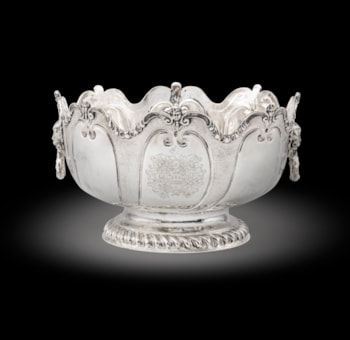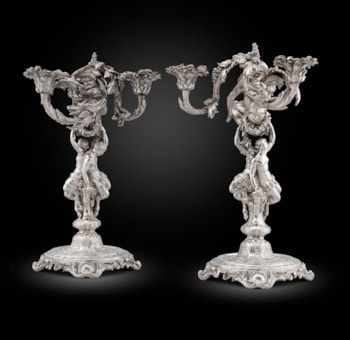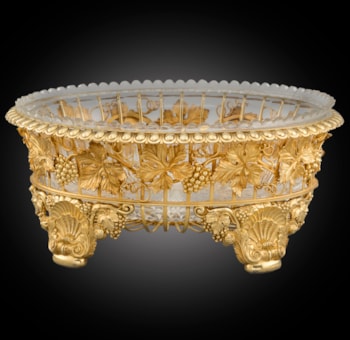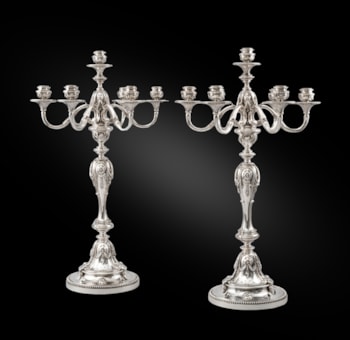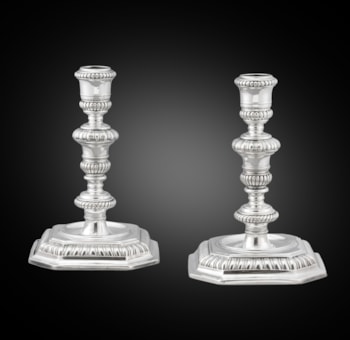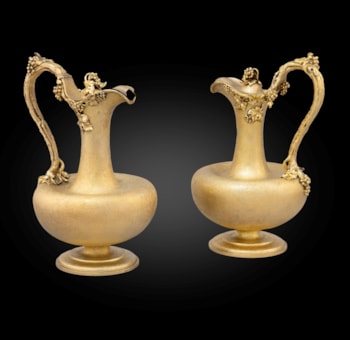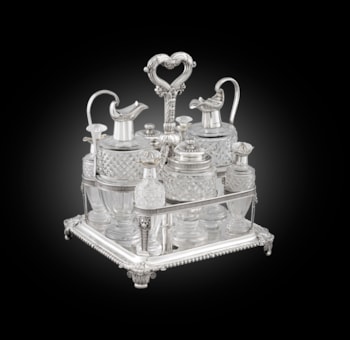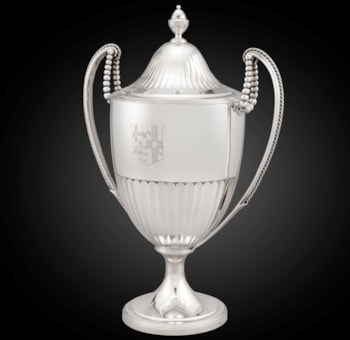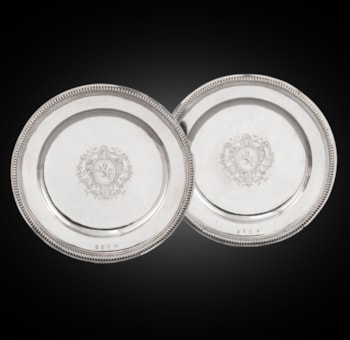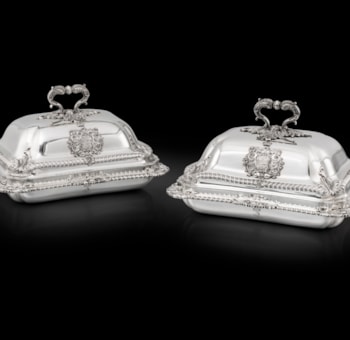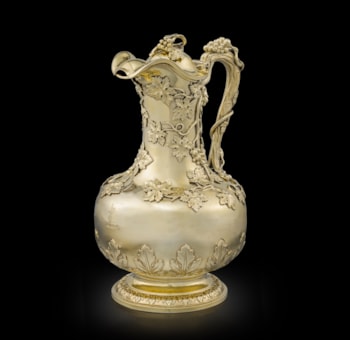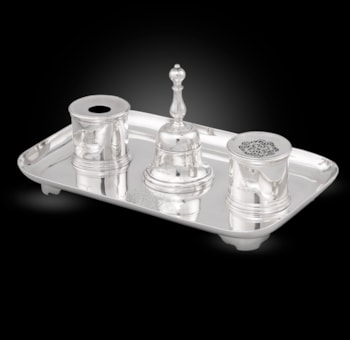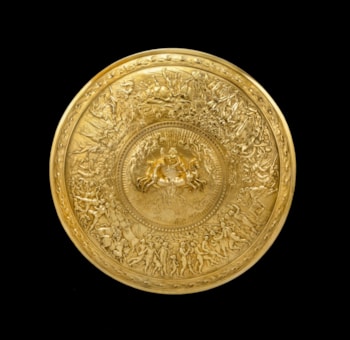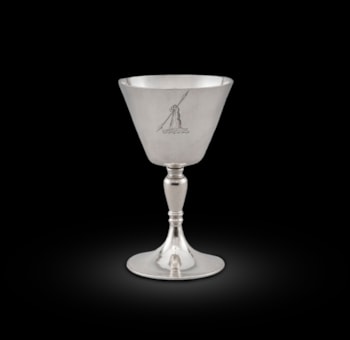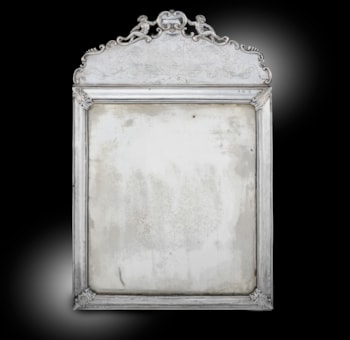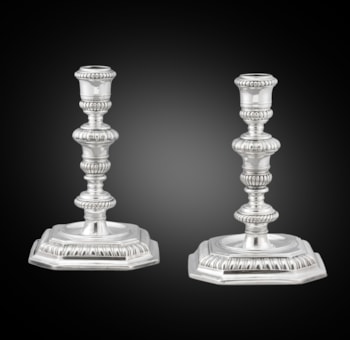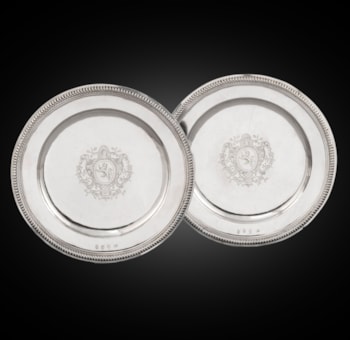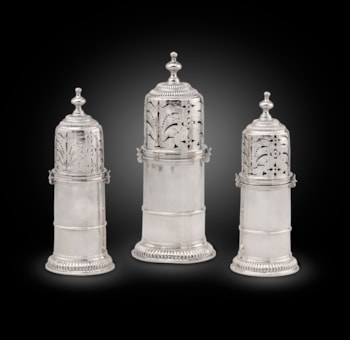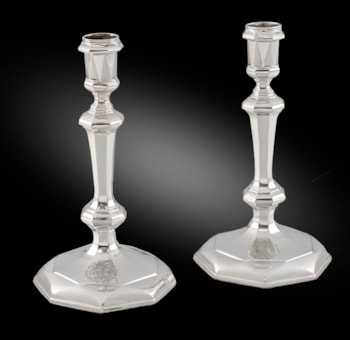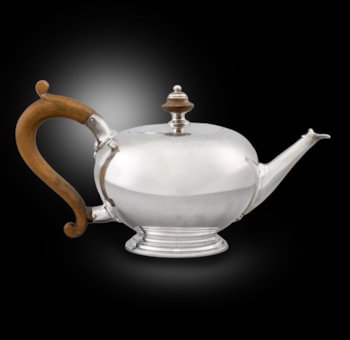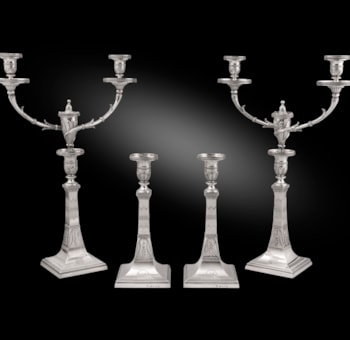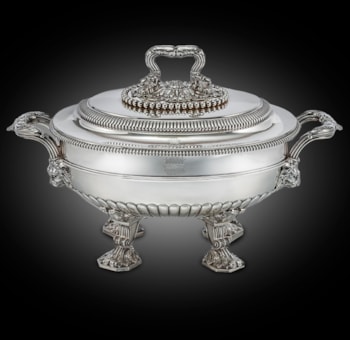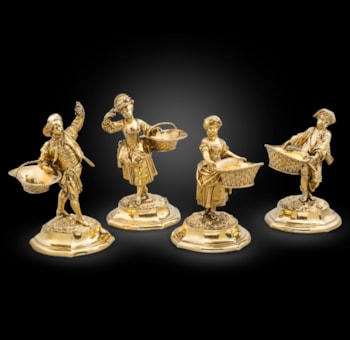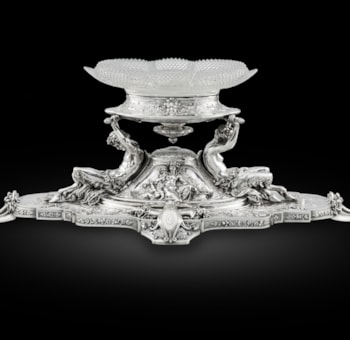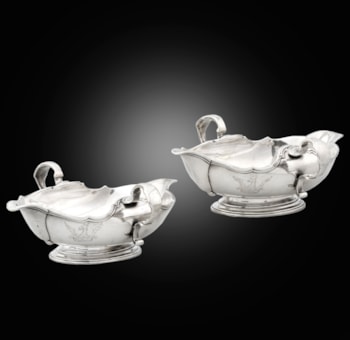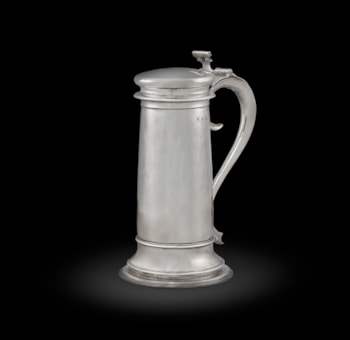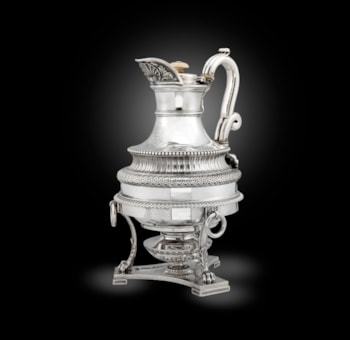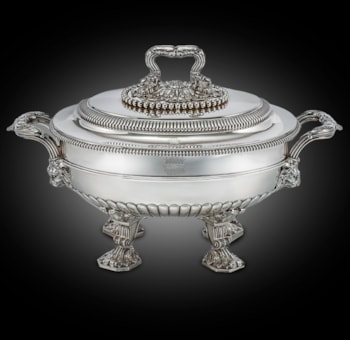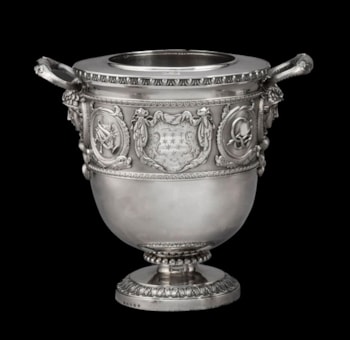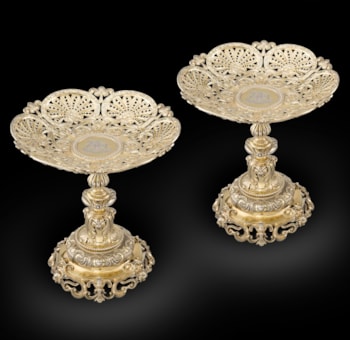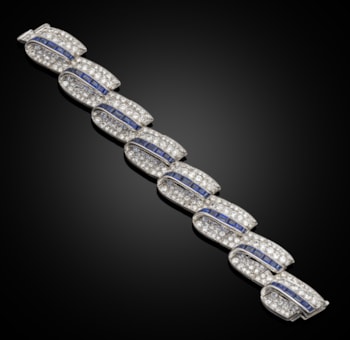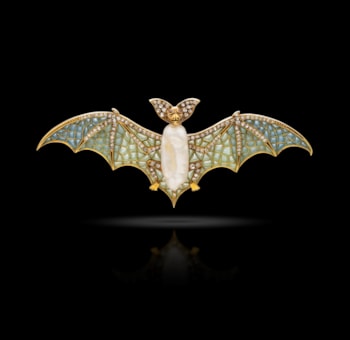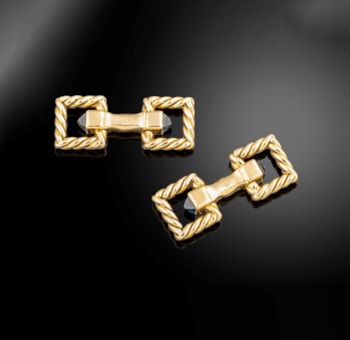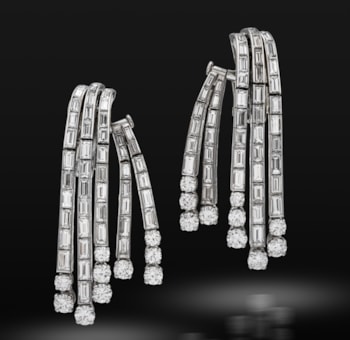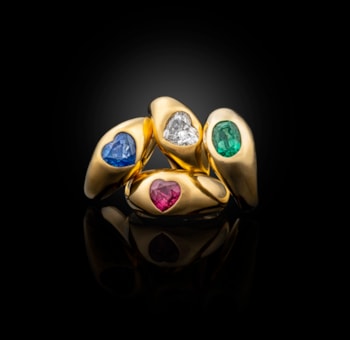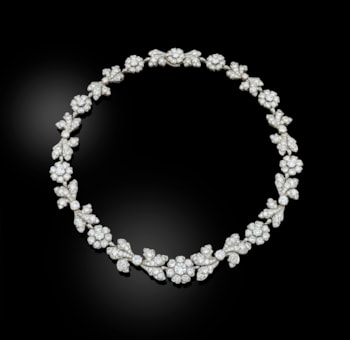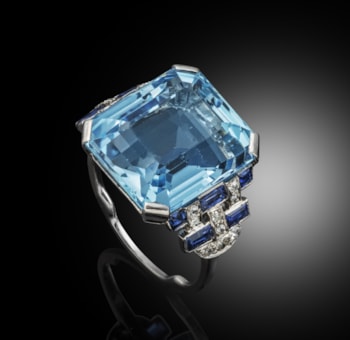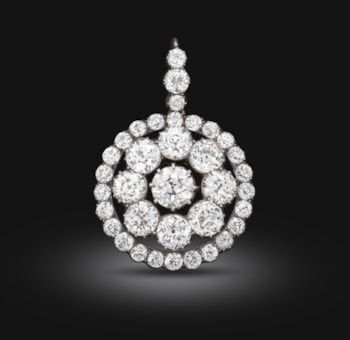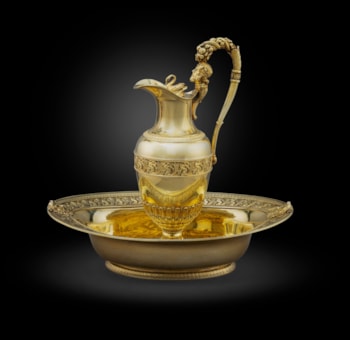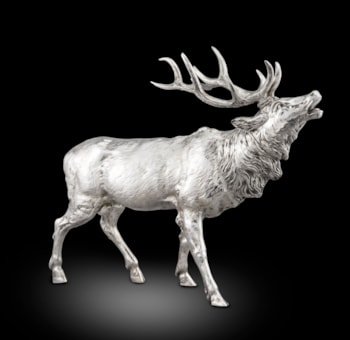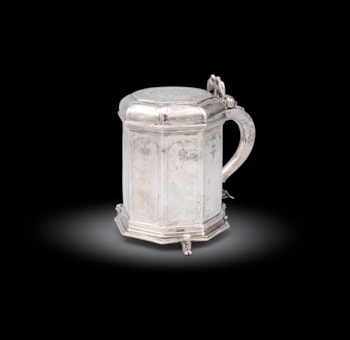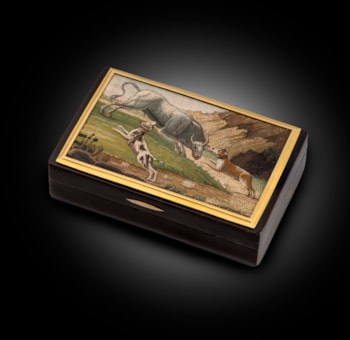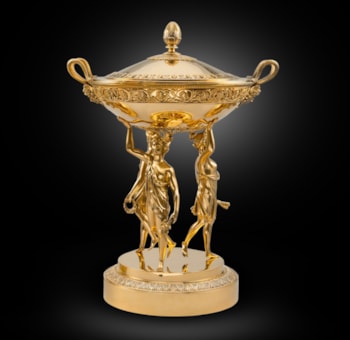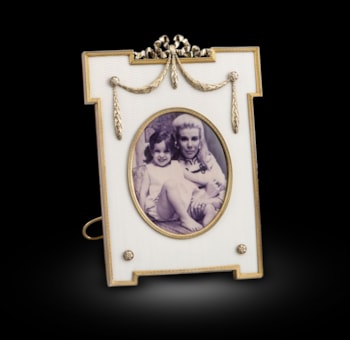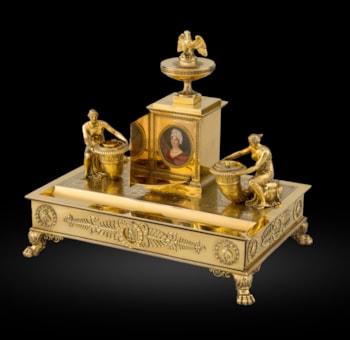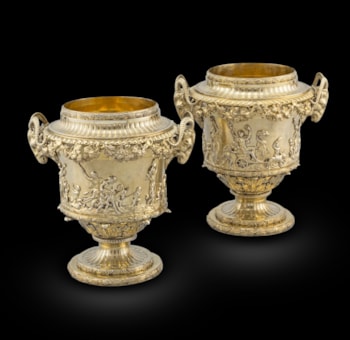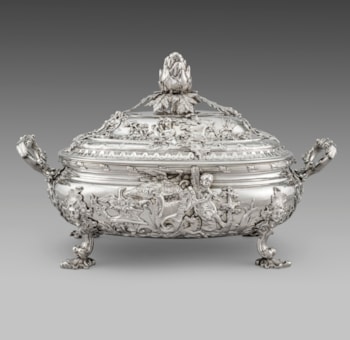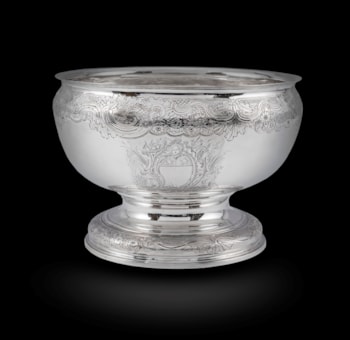The Neptune centrepiece in the Royal Collection has been discussed at length by Kathryn Jones and Christopher Garibaldi (‘Crespin or Sprimont? A Question Revisited”, Silver Studies, the Journal of the Silver Society, No. 21, 2006, pp. 24-38). Described as ‘the purest rococo creation in English silver’, it formed part of the table service displaying the most advanced French taste of the period. The marine theme of the piece, with its Neptune finial, swags of shells and pieces of coral and detachable dishes in the form of abalone shells, suggests it was used to serve fish soups and seafood. Bearing the touch mark of Paul Crespin on the plateau it is accompanied by sauceboats of 1743 and four salts which are by Nicholas Sprimont. It was further embellished by Rundell, Bridge and Rundell in 1826 by raising it on glorious hippocampi. The centrepiece modelled as a large shell supported by a frothing pillar of water, the triform base guarded at each of its three points by hippocamps on a crashing wave base, the feet composed of turtles, coral and shells, the bowl engraved with two coats-of-arms.
In 1826 George IV commissioned further pieces to increase the splendour and magnificence of the service. This Ferguson centrepiece is the prototype to some of those glorious additions in the Royal marine service. Once more showing the inventiveness and superb art of the goldsmith and Royal retailer’s Rundell, Bridge & Rundell.
Here our centrepiece rests on a shaped triangular base cast and chased with waves resting on turtles, shell and coral, the large shell shaped body held by three seahorses, engraved on lip with two coats-of-arms.

The FitzGibbon, 1st Earl of Clare’ centrepiece 1780 by James Young
Formerly in the Koopman Rare Art Collection and after the Neptune Royal Centrepiece made for Frederick Prince of Wales 1741-2
Here we see how the Royal Centrepiece must have looked before being wonderfully embellished by Rundell, Bridge & Rundell in 1826
Robert Ferguson of Raith

The Archers by Sir Henry Raeburn illustrates Robert with his brother Ronald
The first arms are those of Ferguson of Raith, Fife, with Hamilton-Nisbet in pretence for Robert Ferguson, eldest son of William Ferguson (formerly Berry) of Raith and his wife, Jean, daughter of Ronald Craufurd of Restairig, Edinburgh. He was born on 8 September 1769 and educated at Edinburgh and Glasgow University.
The second arms are those of Hamilton-Nisbet in a lozenge.
‘As a young man, Mr Ferguson was beloved by the neighbourhood for his frank and generous spirit and admired for his elegant and manly beauty. His earlier studies were directed to the bar; and, after qualifying in Edinburgh, he entered the Faculty of Advocates in 1791. Mr Ferguson never practiced: he acquired his legal knowledge not as a profession, but as a requisite in the education of a gentleman.
‘After acquiring all the education that is usually afforded to gentlemen of his rank in this country, Mr Ferguson visited and spent many years of his life in most of the continental states. . .. Having had the misfortune, or rather we would say the good fortune; to be one of those Englishmen [sic] detained in France by the Revolutionary Government, he spent many years of his life in Paris during the career of Buonaparte, and witnessed the progress of events in that most interesting period. . .. As a linguist, Mr Ferguson wrote and spoke several European languages with equal ease and facility. . .. Mr Ferguson was partly indebted to his early friend and model [the prominent British Whig statesman] Mr [Charles James] Fox [1749-1806], for the attention he met with in France, and to him, we believe, was he indebted for his ultimate liberation. On his return to Scotland, he was returned to Parliament for the county of Fife, in 1806, and from this period we may date the commencement of Mr Ferguson’s public career. His parliamentary services have not been continuous, but he has successively been returned for the Kirkaldy Burghs, at the elections of 1831, ‘32, and ‘37. In 1835 he represented the county of East Lothian as a matter of expediency during the Peel administrator of that period.’1

Raith House near Kirkcaldy, Home of Robert Ferguson
Mr. Ferguson’s private interests and marriage
Mr. Ferguson was ‘a member of several learned societies; but though he does not appear to have published any scientific memoirs, he was eminent as an enthusiastic patron of science, and an encourager of knowledge of very description, Mineralogy, geology, and the fine arts were his favourite pursuits.’2
Robert Ferguson was married to Mary (d. 1855), daughter and heir of William Hamilton Nisbet (1747-1822) of Dirleton and Belhaven, Haddington, and the divorced wife of Thomas, 7th Earl of Elgin, later 11th Earl of Kincardine (1766-1841). His lordship had successfully petitioned for a divorce from his wife for her adultery with Ferguson, a scandal of the season. The matter was finally resolved at the Court of Sessions, Edinburgh on 11 March 1808 and the couple were married a little under six weeks later on 20 April.3 Ferguson was latterly Lord-Lieutenant of Fife and died at his London house, 18 Portman Square on 3 December 1840.
Rundell, Bridge & Rundell and John Flaxman

Inspired by the naturalism of the Marine Service made for Frederick,
Prince of Wales, in the 1740’s, this sumptuous tureen is one of four supplied to the king by Rundell,
Bridge & Rundell between 1826-1829
Four silver-gilt soup tureens and covers (mark of John Bridge, London, 1826) of the same design as this present centrepiece were supplied by Rundell, Bridge & Rundell to George IV as part of his Grand Service. They were designed to match the Marine Service of rococo silver made in the 1740s for Frederick, Prince of Wales. This present centrepiece, however, and another silver example of 1824, predate George IV’s tureens, suggesting that they were prototypes. The late Shirley Bury, author of the groundbreaking series of articles, ‘The Lengthening Shadow of Rundell’s,’ published in The Connoisseur during 1966, was of the view that the sculptor John Flaxman (1755-1826), who during the closing years of his life was Rundell’s art consultant, was responsible for the firm’s revival of the rococo style and use of botanical and aquatic naturalism.

John Flaxman © National Portrait Gallery
In part, Mrs. Bury based her opinion on an 1844 report that the colossal 8,000 ounce silver-gilt wine cooler ordered by George IV from Rundell’s in the mid-1820s and delivered after his death in 1830, was ‘modelled by Flaxman.’4 The suggestion was endorsed more recently in the catalogue issued in 2002 to accompany the Royal Treasures exhibition at the Queen’s Gallery, Buckingham Palace: ‘[Rundell’s] also drew inspiration from the sixteenth- and seventeenth- century plate: the hippocampus or seahorses which support the bowl . . . are derived from an early seventeenth century nautilus cup [by Nikolaus Schmidt (1550/55-1609) of Nuremberg], considered by Flaxman to be by Cellini, sold to George IV by Rundell’s in 1823. These revivalist styles of the 1820s were revolutionary departures after decades of classicism.’5
Notes
1. The Fife Herald, Cupar, Thursday, 10 December 1840, p. 3a/b
2. John Evans, et al, editors, The Numismatic Chronicle, third series, vol. XI, London, 1891, p. 87
3. The Northampton Mercury, Northampton, Saturday, 2 April 1808, p. 1
4. The Illustrated London News, London, Saturday, 21 September 1844, p. 178a
5. Jane Roberts, editor, Royal Treasures: A Golden Jubilee Celebration, London, 2002, p. 267
John Ferguson M.P. (1770-1840), of Raith, Fife and Portman Square, London
A Gentleman; Christie's, London, 29 June 1955, lot 8 (£210).
With Koopman Rare Art, London, 2013.
Hotel Lambert, Une Collection Princière, Volume IV : Les Arts de la table; Sotheby's, Paris, 14 October 2022, lot 884.
E. Alfred Jones, The Gold and Silver of Windsor Castle, Arden Press, Letchworth, 1911, pl. LXXXI, p.160
Shirley Bury, 'The lengthening shadow of Rundell's,' pt 2, 'The substance and growth of the Flaxman tradition,' The Connoisseur, March 1966, p.152
Charles Oman, 'A Problem of Artistic Responsibility: The Firm of Rundell, Bridge & Rundell,' Apollo, March 1966, p. 181
David Bindman, editor, John Flaxman, R.A., Royal Academy or Arts, Thames & Hudson, 1979, pp.142 and 148
Christopher Hartop, Royal Goldsmiths: The Art of Rundell & Bridge 1797-1843, John Adamson, Cambridge for Koopman Rare Art, London, 2005, pp. 87 and 95
John Bridge (Dorset 1755 - London 1834) The eldest son of Thomas Bridge of Piddle Trenthide Dorset, born 21 January 1755. He was a co-founder of the greatest 19th century retailers to ever grace England, Rundell Bridge & Rundell, Royal retailers to the Prince Regent. Employing some of the most eminent craftsmen of his day. Both new and old silver, jewellery, objects of virtue and watches made up the vast stock at the London shop at number 32 Ludgate Hill. By the 1820's, it was a vast enterprise with agencies in Paris, Vienna, St. Petersburg, Baghdad, Constantinople, Bombay, Calcutta, and various cities in South America. The success was as much due to the endeavours of John Bridge as to Rundell's own ruthless character and the beauty and quality of the merchandise. Rundell & Bridge were a London firm of jewellers and goldsmiths formed by Philip Rundell (1746–1827) and John Bridge (1755–1834). When Edmond Waller Rundell, nephew of Philip Rundell, was admitted as a partner in 1804, the firm's name changed to Rundell, Bridge & Rundell. That same year John Gawler Bridge, nephew of John Bridge also joined the firm. Following John Bridge's death in 1834 a new partnership was formed comprising John Gawler Bridge, Thomas Bigge, John Bridge's nephews and Bigge's son, and the firm changed its name to Rundell, Bridge & Co. The firm was appointed as one of the goldsmiths and jewellers to the king in 1797 and Principal Royal Goldsmiths & Jewellers in 1804, and the firm held the Royal Warrant until 1843. After the Congress of Vienna (1814-15), the firm prepared 22 snuffboxes to a value of 1000 guineas each to be given as diplomatic gifts. Amongst its employees were the well-known artists John Flaxman and Thomas Stothard, who both designed and modelled silverware. Directing their workshops from 1802 were the silversmith Benjamin Smith and the designer Digby Scott, and in 1807, Paul Storr, the most celebrated English silversmith of the period, took charge, withdrawing from the firm in 1819 to establish his own workshops. The Royal Goldsmiths served four monarchs: George III, George IV, William IV and Victoria. In addition, their name was attributed to the 'Rundell Tiara', made for Princess Alexandra in 1863.
You May Also Like




